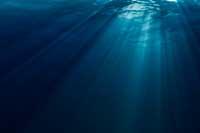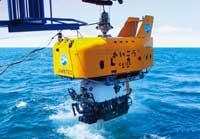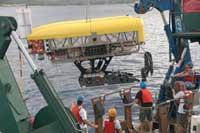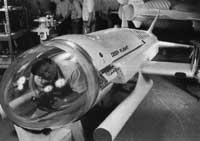Eleven thousand meters under water
2009/09/27 Korta Hernandez, Nerea - Elhuyar Zientziaren Komunikazioa

It is four billion years old and covers 70% of the land surface. It was the reason for the creation of life and is its support. Although the human being has always been by the side, experts say that only 5% of the oceans are known. How is it possible?
The seabed is not flat. Up to two hundred meters deep, there is a continental shelf, very flat and that houses most of the fish. Three thousand meters from the two hundred is the continental slope, with more slope, to which no longer comes light. From there begins the marine bottom, with abyssal plains to four thousand meters of depth. In the center of the ocean there are dorsal, underwater chains joined together. And the deepest areas of the oceans are the graves at an average depth of between seven and eight thousand meters. The deepest is the grave of the Marianas: 11,000 meters.
This fossa is located to the east of the Mariana islands, to the west of the Pacific. In addition to being the deepest ocean fossa, it is the deepest place on earth's surface. And there is the Challenger well, the deepest point of all. According to data from National Geographic, it is 11.034 meters below sea level. At this depth the pressure is a thousand times greater than that of the atmosphere at sea level.

Japanese boat of the dock. In 1995 he made his first dive in the Mariana trench. In total it was immersed three times in the Challenger (Photo: JAMSTEC).
Dives of Challenger
The man, despite the difficulties, has tried to reach this harsh environment. The first survey was conducted in 1875 by scientists of the Challenger expedition, hence the name of the osina. 8.184 meters deep. In 1951, the British Royal Navy sent a boat of the same name in homage to the first, and conducted a more accurate survey: The resulting draft was 10,900 metres.
The next step was to submerge the man. In 1960, the Trieste icebreaker plunges into the Challenger well, with two crew members. It was designed in Switzerland, built in Italy and acquired in 1958 by the American army. There traveled Jacques Piccard, son of the inventor of the ship and Don Walsh. They reached a depth of 10,916 meters. After twenty minutes in the background, they returned. Since that dive, Trieste is the deepest and unique manned ship. In fact, those who have arrived later have been unmanned.
It was a Japanese boat driven from far by the pier. In 1995 it surpassed the record of unmanned dives, descending to 10,911 meters in the Challenger Well. He made three dives in the Marianas trench, the last one in 1998. During these dives he photographed worms and kisquillas and received samples from different macroorganisms. In 2003 the connecting cable was broken and the container was lost. It is considered the most accurate measurement of the depth made by the Pier.

Launching the underwater robot Nereus. His first dive in Challenger in 2009. Currently is the boat that is most immersed (Photo: WHOI).
Last May, an unmanned hybrid design robot plunged into the Challenger. The Nereus reached 10,902 meters of depth. He spent ten hours in the background, driven through a fiber optic rope by a boat located on the surface, although it can become an autonomous vehicle. Created by the Woods Hole Oceanographic Institute, its authors say it will serve to virtually analyze the graves. It is the vehicle that is most immersed of the currently in operation, since the rest reaches a maximum distance of 6.500 meters.
Now oceanographers have a tool with no depth limits for data collection, images and samples. Nereus has brought the possibility of reaching previously inaccessible places. The unknown world of the sea opens to man.
Published in 7K.

Gai honi buruzko eduki gehiago
Elhuyarrek garatutako teknologia





